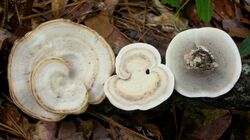Biology:Mycorrhaphium
From HandWiki
Short description: Genus of fungi
| Mycorrhaphium | |
|---|---|

| |
| Mycorrhaphium adustum | |
| Scientific classification | |
| Kingdom: | |
| Division: | |
| Class: | |
| Order: | |
| Family: | |
| Genus: | Mycorrhaphium Maas Geest. (1962)
|
| Type species | |
| Mycorrhaphium adustum (Schwein.) Maas Geest. (1962)
| |
| Species | |
| |
Mycorrhaphium is a genus of fungi in the family Steccherinaceae.[1] The genus was circumscribed by Dutch mycologist Rudolph Arnold Maas Geesteranus in 1962. The type species is Mycorrhaphium adustum (formerly referred to Hydnum). Fruit bodies of species in the genus have caps, stipes, and a hydnoid (tooth-like) hymenophore. There is a dimitic hyphal system, where the skeletal hyphae are found only in the tissue of the "teeth", and a lack of cystidia. The spores are smooth, hyaline (translucent), and inamyloid.[2]
Walter Jülich created the family Mycorrhaphiaceae to contain the type genus Mycorrhaphium.[3] This family is now placed in synonymy with Steccherinaceae.[4]
Species
- M. adustulum (Banker) Ryvarden (1989) – Europe, North America
- M. adustum (Schwein.) Maas Geest. (1962)
- M. africanum Mossebo & Ryvarden (2003)– Africa (Cameroon)[5]
- M. citrinum Ryvarden (1989) – Africa (Zambia)[6]
- M. pusillum (Brot.) Maas Geest. 1962) – Europe[7]
- M. sessile H.S.Yuan & Y.C.Dai (2009) – China[8]
- M. stereoides (Cooke) Maas Geest. (1971) – Europe
References
- ↑ Miettinen, Otto; Larsson, Ellen; Sjökvist, Elisabet; Larsson, Karl-Henrik (2012). "Comprehensive taxon sampling reveals unaccounted diversity and morphological plasticity in a group of dimitic polypores (Polyporales, Basidiomycota)". Cladistics 28 (3): 251–270. doi:10.1111/j.1096-0031.2011.00380.x. https://www.researchgate.net/publication/256859903.
- ↑ Maas Geesteranus, R.A. (1962). "Hyphal structures in Hydnum". Persoonia 2 (3): 377–405 (see p. 394). http://www.cybertruffle.org.uk/cyberliber/61056/0002/003/0394.htm.
- ↑ Jülich, Walter (1981). Higher Taxa of Basidiomycetes. Bibliotheca Mycologica. 85. Vaduz: J. Cramer. p. 380.
- ↑ Justo, Alfredo; Miettinen, Otto; Floudas, Dimitrios; Ortiz-Santana, Beatriz; Sjökvist, Elisabet; Lindner, Daniel; Nakasone, Karen; Niemelä, Tuomo et al. (2017). "A revised family-level classification of the Polyporales (Basidiomycota)". Fungal Biology 121 (9): 798–824. doi:10.1016/j.funbio.2017.05.010. PMID 28800851.
- ↑ Mossebo, D.C.; Ryvarden, L. (2003). "The genus Mycorrhapium in Africa". Mycotaxon 88: 229–232. http://www.cybertruffle.org.uk/cyberliber/59575/0088/0229.htm.
- ↑ Ryvarden, L. (1989). "Mycorrhaphium citrinum sp. nov. (Aphyllophorales, Basidiomycetes)". Memoirs of the New York Botanical Garden 49: 344–7.
- ↑ Tervonen, K.; Spirin, V.; Halme, P. (2015). "Redescription of Mycorrhaphium pusillum, a poorly known hydnoid fungus". Mycotaxon 130 (2): 549–554. doi:10.5248/130.549.
- ↑ Yuan, H.S.; Dai, Y.C. (2009). "Hydnaceous fungi of China 2. Mycorrhaphium sessile sp. nov.". Nova Hedwigia 88 (1–2): 205–209. doi:10.1127/0029-5035/2009/0088-0205.
Wikidata ☰ Q6947170 entry
 |

